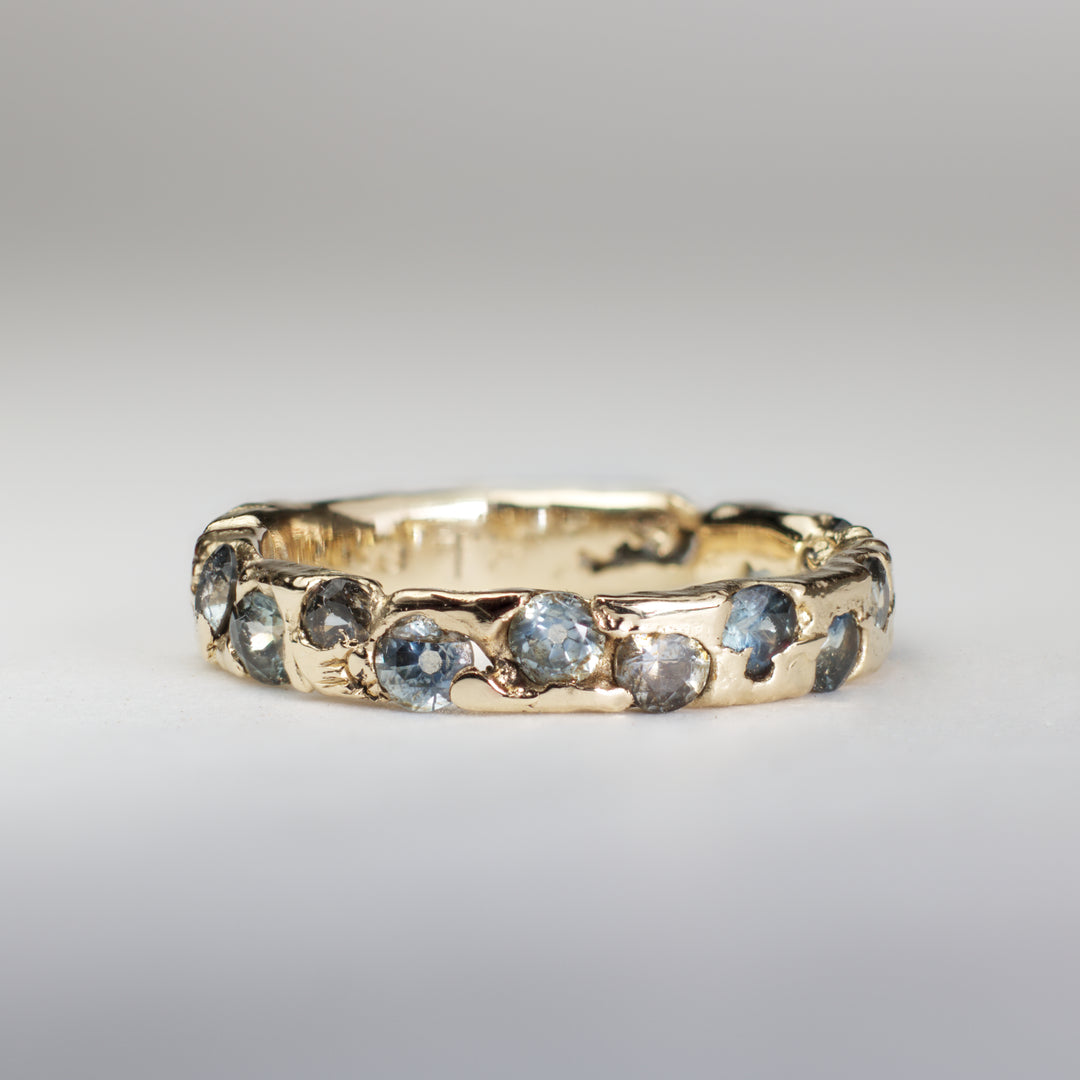How to Choose Between Heated and Unheated Montana Sapphires
Most sapphires you see in stores have been heated to look perfect. But at Rigby Leigh, most of ours aren’t, especially when it comes to Montana sapphires.
Montana sapphires are known for their unusual colors: mossy greens, smoky blues, and bright teals. Many jewelers heat them to intensify their color and clarity, transforming a soft-toned stone into a more “marketable” version.
But at Rigby Leigh, we do the opposite. We work with Montana sapphires exactly as they come out of the earth: untreated, unheated, and full of character.
If you’re new to gemstone buying, the difference between heated and unheated sapphires, especially Montana ones, can be confusing. Here’s what heat treatment actually does, why it’s so common, and why we choose to work almost exclusively with natural, unheated stones.

What Is a Heated Sapphire?
Heat treatment is one of the oldest and most common ways to improve a gemstone’s appearance. Jewelers place sapphires in a furnace at extremely high temperatures (often 1,500°C or more) for hours or even days.
This process can:
- Intensify color: turning pale stones a richer blue or green.
- Improve clarity: reducing the visibility of inclusions or cloudiness.
- Even out color zoning: making the stone look more uniform.
It’s easy to see why heat-treated sapphires are so popular. The color becomes more predictable and buyers get the “classic” look they expect. The process is stable and permanent and doesn’t fade over time.
Heat-treated Montana sapphires are especially common, because some rough stones from this region emerge pale or with uneven color zoning. With heat, those stones can be transformed into deep blues or teals that fit mainstream expectations.
But when you heat a sapphire, you’re changing it from its natural state, and for us, that changes the story it tells.

What Is an Unheated Sapphire?
Unheated sapphires, also called untreated sapphires, are exactly as they came from the earth: no high-temperature treatments to alter their color or clarity.
They’re rare: only about 1% of sapphires on the market are truly unheated.
Unheated Montana sapphires tend to:
- Show natural color variations — often softer, earthier, or multicolored tones.
- Keep their original inclusions, giving them unique patterns and internal character.
- Appeal to collectors and ethical jewelers for their authenticity and rarity.
At Rigby Leigh, we work with these natural, unheated stones, even when that means choosing a mossy green or a steely grey-blue instead of a saturated royal blue. We believe the variation is the beauty.
Are Heated Sapphires Less Valuable?
Not always. Value depends on a number of factors like color, clarity, cut, size, and origin, not just whether a stone has been heated.
A vivid, well-cut heated sapphire can still be valuable. But when all other qualities are equal, unheated stones usually command higher prices because of their rarity and appeal to collectors and purists.

Why We Choose Unheated Stones at Rigby Leigh
Our founder and designer, David Watkins, has a simple philosophy: Let the stone speak for itself.
We pair these natural sapphires with wood-cast gold and hand-cut settings, creating jewelry that’s as raw, rare, and real as the land the stones came from. No two pieces are ever the same, because no two sapphires are ever the same.
We also care deeply about how and where our materials are sourced. Every one of our Montana sapphires comes from a small-scale mine that avoids harsh chemicals and respects the land.
These stones are mined and cut by hand, and we honor that by leaving their natural color and inclusions intact.
Learn more about our Gold & Jewel Sources
Design a Custom & Bespoke Ring
How to Tell If a Sapphire Has Been Heated
Heated Montana sapphires tend to look more uniform, with bold, consistent color that tends towards steely blue in tone. The reason that heated Montana Sapphires are often more blue in color is because in the heating process this Ruitle ‘silk’ dissolves into the stone, which turns the Montana Sapphire blue.
Unheated stones usually show more natural variation like soft color zoning, mossy or smoky tones, and tiny inclusions or “silk” inside the gem, though there are also many clean and clear unheated Montana Sapphires!
At Rigby Leigh, we’ll always tell you whether your stone is heated or unheated. Contact Us with Questions.

Choosing the Right Sapphire for You
Heated sapphires aren’t “bad”, they’re just different. And for many people, they’re the right choice.
If you want bold, consistent color and a more traditional look, a heated sapphire may be right for you, though again many of our unheated sapphires offer this too.
If you’re drawn to rarity, uniqueness, and stones with real personality, an unheated sapphire, especially one from Montana, is probably where you will be drawn. These are stones that haven’t been altered to fit a standard mold. They’re natural, expressive, and tell a story that’s all their own.
Both types are beautiful and durable enough for daily wear, and the better choice is simply the one that aligns with your values, budget, and aesthetic. Ultimately you should choose the stone that you fall in love with, it’s as simple as that.
Explore Our Montana Sapphire Collection
FAQs
Are heated sapphires less valuable?
Not automatically. Value depends on many factors: color, clarity, cut, size, and origin. Heated sapphires can still be incredibly valuable, but unheated stones of similar quality tend to be rarer, and that rarity often increases value. Collectors and gemstone purists will often pay a premium for natural, untreated sapphires.
Are Montana sapphires heated?
Yes, many Montana sapphires are heated. Heat treatment is a common practice for Montana sapphires, especially to deepen their blues and make color more uniform. Without heat, Montana sapphires often show colors like moss green, steel blue, pale yellow, or mixed zoning.
At Rigby Leigh, we focus exclusively on unheated stones. We believe their raw, natural look is more honest and expressive. And by working only with untreated Montana sapphires, we can trace every stone back to a mine that cares for the land.

Heated sapphires are the industry standard, while unheated Montana sapphires are the exception: rare, ethical, and full of soul.
If you’re looking for a stone that’s naturally beautiful and tells its own story, we’d love to help you find it. Explore Our Collection.





